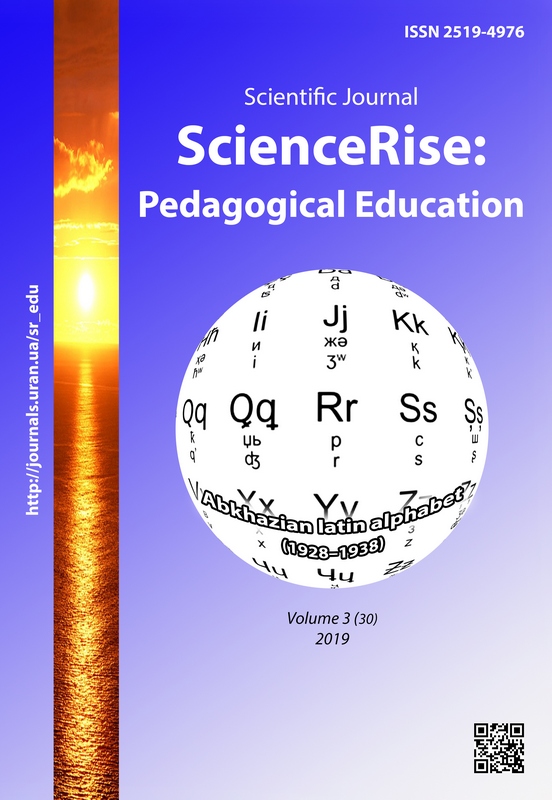Integrative approach to teaching academic writing to the first-year students of the foreign language faculties
DOI:
https://doi.org/10.15587/2519-4984.2019.166289Keywords:
competence, product writing, process writing, academic writing, integration, paragraphAbstract
With the dominance of English as the international language communicating through writing in English is vital for any member of the society who wants to be successful, therefore developing students’ writing skills has been of a current interest in teaching foreign languages at Universities. This article aims to discuss a teaching approach which can provide University students with enough support before they start writing something for academic purposes.
The paper begins with analyzing two approaches to teaching writing that have dominated over the recent years: writing process and writing product, with their advantages and disadvantages. The product approach is a traditional approach focusing on the final product of writing which is the result of students’ mimicking a model text, that is usually analyzed at the initial stage. Emphasis is put on accuracy of produced texts, namely correct and diverse grammar, spelling and vocabulary usage. This approach is popular with teachers due to its easy application.
The process approach tends to focus more on the process of creating a text through the various stages of generating ideas, drafting, revising and editing. Vocabulary and grammar used are not the key factors in assessing the written text. Students are given considerable freedom within the task, so the outcome of writing is not preconceived. Though most of methodologists consider the process approach to be a more effective method of teaching writing teachers often avoid it because of its being time consuming.
Each approach still has some disadvantages that can only be compensated by the advantages of the other. So instead of using either of the approaches in isolation while teaching academic writing, paragraph writing in particular, the article suggests integrating them especially for working with students with a low competence in English. Such integration can facilitate students to generate ideas in a comprehensive manner and provide the students with appropriate support of grammar and vocabulary
References
- Common European Framework of Reference for Languages: Learning, Teaching, Assessment (2001). Council of Europe. Cambridge: Cambridge University Press, 206.
- Andriiko, I. F. (2011). Navchannia nimetskomovnoho tvorchoho pysma studentiv movnykh spetsialnostei [Teaching creative writing in German to the students majoring in languages]. Inozemni movy, 4, 26–29.
- Hedge, T. (2005). Writing. Oxford: Oxford University Press, 154.
- Harmer, J. (2015). The Practice of English Language. Pearson ESL, 350.
- Skliarenko, N. K., Ustymenko, O. M. (2013). Navchannia uchniv zahalnoosvitnikh navchalnykh zakladiv inshomovnoho pysma v aspekti kompetentnisnoho pidkhodu [Teaching foreign language writing to the pupils of comprehensive schools in the context of the competence approach]. Inozemni movy, 3, 3–18.
- Yusupova, L. N. (2015). Napisanie akademicheskogo esse na angliiskom yazyke. Academic Essay Writing. Petrozavodsk: Izd-vo PetrGU, 48.
- Altinmakas, D., Bayyurt, Y. (2019). An exploratory study on factors influencing undergraduate students’ academic writing practices in Turkey. Journal of English for Academic Purposes, 37, 88–103. doi: http://doi.org/10.1016/j.jeap.2018.11.006
- Strobl, C., Ailhaud, E., Benetos, K., Devitt, A., Kruse, O., Proske, A., Rapp, C. (2019). Digital support for academic writing: A review of technologies and pedagogies. Computers & Education, 131, 33–48. doi: http://doi.org/10.1016/j.compedu.2018.12.005
- Johnson, A. P. (2016). Academic writing: process and product. Rowman & Littlefield Publishers, 200.
- Hasan, M. K., Akhand, M. M. (1970). Approaches to Writing in EFL/ESL Context: Balancing Product and Process in Writing Class at Tertiary Level. Journal of NELTA, 15 (1-2), 77–88. doi: http://doi.org/10.3126/nelta.v15i1-2.4612
- Sakoda, N. The distinction between process based and product based approaches to teaching writing and its effects on classroom methodology. Available at: http://harp.lib.hiroshima-u.ac.jp/hue/file/480/20140128154033/40th47.pdf
- Motriuk, N. (2014). Metodychni kontseptsii navchannia inshomovnoho pysemnoho movlennia [Methodological concepts of teaching foreign language writing]. Available at: http://www.rusnauka.com/41_PWSN_2014/Philologia/5_184035.doc.htm
- Tarnopolskyi, O. B., Kozhushko, S. P. (2008). Metodyka navchannia studentiv pysma anhliiskoiu movoiu [Methods of teaching writing in English to students]. Vinnytsia: Nova knyha, 288.
Downloads
Published
How to Cite
Issue
Section
License
Copyright (c) 2019 Наталія Михайлівна Карпенко, Вікторія Володимирівна Смелянська

This work is licensed under a Creative Commons Attribution 4.0 International License.
Our journal abides by the Creative Commons CC BY copyright rights and permissions for open access journals.
Authors, who are published in this journal, agree to the following conditions:
1. The authors reserve the right to authorship of the work and pass the first publication right of this work to the journal under the terms of a Creative Commons CC BY, which allows others to freely distribute the published research with the obligatory reference to the authors of the original work and the first publication of the work in this journal.
2. The authors have the right to conclude separate supplement agreements that relate to non-exclusive work distribution in the form in which it has been published by the journal (for example, to upload the work to the online storage of the journal or publish it as part of a monograph), provided that the reference to the first publication of the work in this journal is included.








